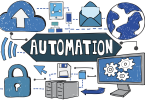Modern mainframe workloads are becoming more complex, as digital priorities drive new requirements for mainframe applications. To address and prevent issues, mainframe operators must have the information they need in a format that the rest of the war room team can understand and act upon.
Given the complexity of modern enterprise IT environments, serious problems inevitably crop up from time to time—problems with no clear fix, likely because it is difficult to determine where the problem is occurring and what its root cause may be.
When such problems arise, it’s time for a situation room – commonly known as the “war room.”
The war room is a crisis management technique that brings together representatives from across the IT landscape to hash out everything they know about the problem at hand. Working together, the theory goes, will lead to a better understanding of the cause of the problem and thus the necessary fix.
The participants in this exercise come from all corners of the IT organization, and in many cases, are people who don’t work together on a day-to-day basis. Each individual brings their own strengths and insights to the table—ideally for better resolution of the problem at hand.
Furthermore, if an issue gets to the war room stage, the problem likely has the attention of executives who will be on the call as well looking over the shoulder of the war room team, increasing the urgency and pressure to solve the problem quickly.
Sometimes, however, communication issues get in the way, as war room participants often speak different jargon. After all, this ad hoc team might consist of network operations, front-end leadership, security operations, cloud management, systems and virtualization operations, mainframe operations, and more.
Of all these various professionals, one stands out as being the one most likely to have communication challenges in a war room environment: the mainframe professional.
From the perspective of everyone else in the room, the mainframe is a world unto its own, with its own jargon, processes, and procedures. Even within the mainframe team, different operators may speak in different terms – and they all want to show the problem isn’t in their area.
The resulting opacity can lead to confusion and even distrust in the war room, torpedoing the collaboration so essential for solving the matter at hand.
Such opacity, however, isn’t a given. With the right tools, the mainframers in the room can provide the insights and information necessary to communicate the mainframe’s contribution to the crisis—or prove the mainframe is not the source of the problem.
Why is the mainframe so opaque? Demystifying the mainframe
In spite of its reputation for opacity, mainframe subsystems and applications generate a surprising quantity of telemetry. Furthermore, mainframe professionals have had access to system monitoring and management tools for generations.
The opacity challenge centers more on the context for such telemetry—how the mainframe ops team interprets the information from their tools and communicates it to the rest of the war room.
Adding to this challenge: the fact that the quantity of data coming from the mainframe continues to explode, just as it does across the rest of the IT landscape.
And yet, while the level of expertise across IT shops generally meets the needs of those organizations, the mainframe world is undergoing a generational shift as the old guard retires, leading to a drop in mainframe expertise in the enterprises most dependent on their mainframes.
Modern mainframe workloads are also becoming more complex, as digital priorities drive new requirements for mainframe applications. For example, a bank may have traditionally run only its core transaction processing on the mainframe, but now supports its mobile apps, business analytics, and AI-centric apps like fraud detection as well.
Not only are there more such applications running on the mainframe, but the corresponding workloads are interdependent—and typically require real-time responses (think fraud detection at the point of sale, for example).
All these forces of change are impacting the ability for the mainframe operators in the war room to have the information they need in a format that the rest of the team can understand and act upon.
Bringing modern mainframe observability to bear
The solution to the problem of mainframe opacity in the war room is to leverage modern mainframe observability tooling like BMC AMI Ops, which helps both seasoned and junior mainframe operators gain real-time insights into mainframe performance within the context of the modern IT landscape.
BMC AMI Ops establishes the baseline for mainframe performance and then continually compares mainframe behavior to that baseline, providing real-time visibility into any underlying issues with mainframe subsystems.
Using minute-by-minute comparisons and multivariate analysis, BMC AMI Ops can detect issues earlier than previously possible, freeing up the team’s time to work on the issue before it impacts customers.
As a result, BMC AMI Ops can identify the root causes of suspected issues, while also taking proactive steps to optimize the mainframe’s performance.
This ability to proactively deal with issues supports the mainframe operator in the war room, as it makes clear whether the mainframe is contributing to the issue at hand.
This focus provides the war room with either an “all clear” for the mainframe, or in the rare case where the problem is actually with the mainframe, BMC AMI Ops provides the information necessary to address the problem.
The Intellyx take
Observability is more than monitoring—it refers to the ability for a system like a mainframe to provide the telemetry necessary to understand the causes of issues and provide the data required to make any necessary fixes.
When mainframe operators present such insights in a war room situation, they can participate fully in the analysis of the crisis at hand, without the traditional opacity of the mainframe getting in the way.
Not only does this ability to participate lead to faster fixes, it also improves the ability of the war room team to collaborate, thus improving morale and better collaboration in the future.
In fact, the mainframe world must be able leverage a combination of systems monitoring for the mainframe, observability for the mainframe, as well as automation. If mainframe leaders leverage these tools together, they might be able to avoid the war room altogether.
No longer does the mainframe have to stand separately in the war room. With tools like BMC AMI Ops, mainframes are full-fledged participants in modern IT environments, war room or no.
Copyright © Intellyx LLC. BMC is an Intellyx customer. Intellyx retains final editorial control of this article. No AI was used to write this article.







